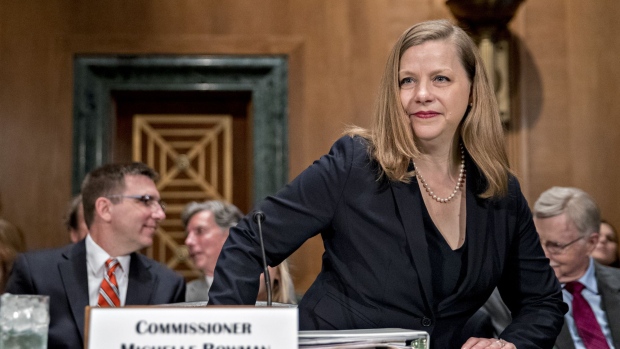Feb 17, 2023
Fed’s Barkin Favors Quarter-Point Rate Hikes for Flexibility
, Bloomberg News

(Bloomberg) -- Two Federal Reserve officials said that interest rates need to keep rising, with one arguing they should keep moving at a gradual pace.
“I like the 25 basis-point path,” Richmond Fed President Thomas Barkin told reporters Friday in Rosslyn, Virginia. It “gives us the flexibility to respond” to data as it comes in, he said, adding that he supported the move at the most recent policy-setting meeting.
Governor Michelle Bowman, speaking at a separate event in Nashville, Tennessee, said “we’ll have to continue to raise the federal funds rate until we start to see a lot more progress” on reducing inflation.
They were the latest policymakers to warn the Fed was not finished in its most aggressive tightening campaign in a generation, following remarks from their colleagues cautioning that rates may need to go higher than previously thought.
Fed presidents Loretta Mester of Cleveland and James Bullard of St. Louis, two of the central bank’s most hawkish officials, said earlier this week that policymakers need to be open to bigger rate hikes going forward if economic conditions warrant.
Recent data suggest the economy is not slowing despite the Fed’s aggressive actions, and investors have pushed up where they see rates peaking later this year.
US central bankers have seen interest-rate-sensitive sectors of the economy slow as a result of their tightening campaign, which began a year ago. The benchmark lending rate has jumped from zero to a range of 4.5% to 4.75%. However, growth appears resilient, with the economy adding more than a half-million jobs in January, and inflation still running at 5% for 2022.
Fed officials stepped down the pace of increases to a quarter-point move at their meeting in early February from a half point in December and a series of four 75 basis-point hikes before that.
“Moving inflation back to target will require more rate increases,” the Richmond Fed chief said. “How many of those, I think we will have to see.”
Officials have said the slower pace will allow them to better assess how monetary policy is working its way through the economy.
Banks and traders on Wall Street increased their bets for more hikes from the Fed and now see rate increases at the March, May and June meetings, with rates peaking at almost 5.3%. Fed officials in December forecast rates peaking at 5.1%, according to their median projection. They release a fresh forecast in March.
Government data earlier this week showed US consumer prices climbed 6.4% in January from a year earlier, higher than economists expected and still far above the Fed’s goal for 2% annual inflation, which is based on a separate measure.
“I don’t think anyone can argue that inflation is much too high,” Bowman said. “I think we’re seeing a lot of really inconsistent data in the economic conditions.”
Asked what she would need to see to favor pausing rate increases, Bowman said it would be “a consistent decline in inflation,” while the evidence suggests that the Fed hikes so far were not yet slowing the economy and borrowing costs had not yet reached a sufficiently restrictive level.
“We’re not finished yet. We haven’t beaten inflation,” she said, without providing further clues on how high she favors going or whether the Fed should revert to larger rate moves to reach that destination.
©2023 Bloomberg L.P.





